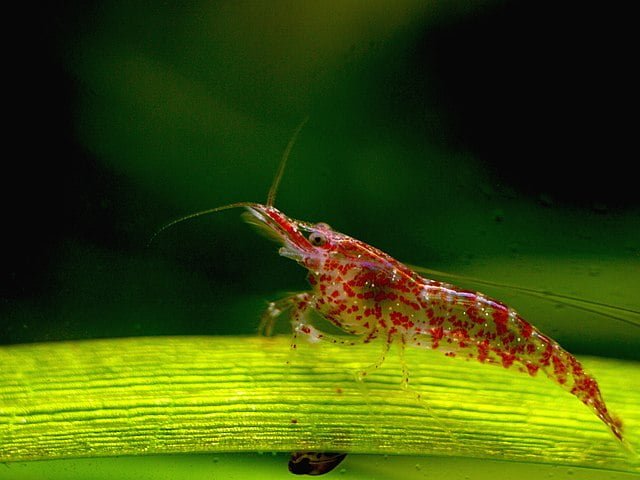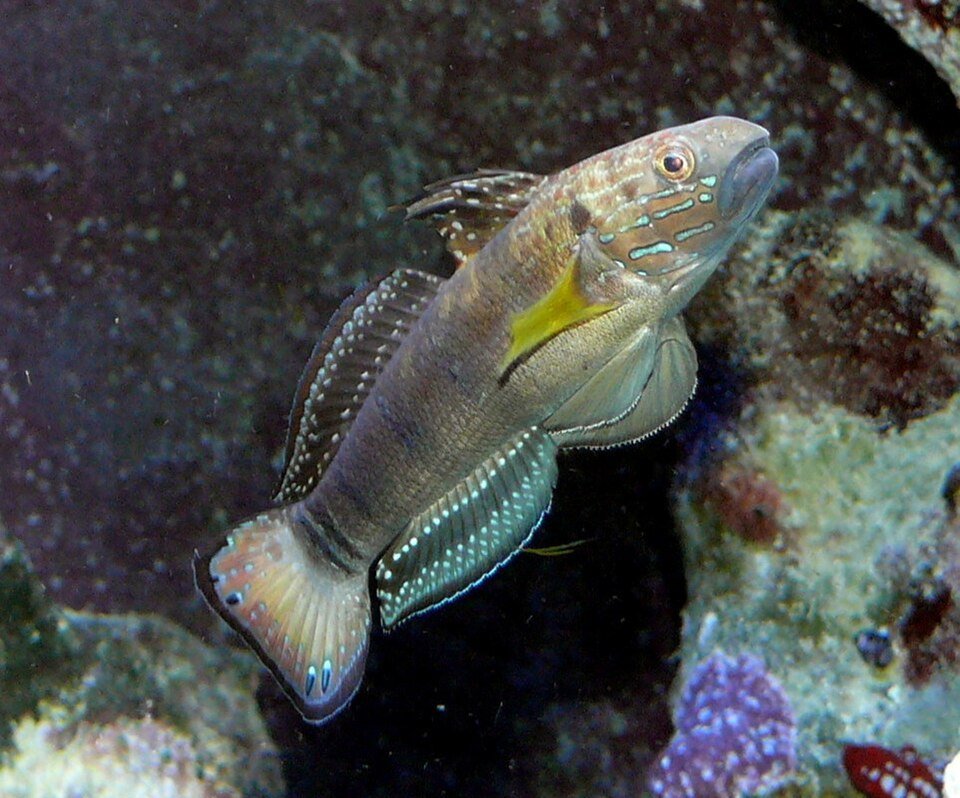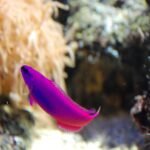
The Fire Goby or Fire Dartfish, Nemateleotris magnifica, also known as the Firefish Goby or Magnificent Dartfish, is one of the most captivating and popular species in the world of marine aquaria. This small fish, with its distinctive vibrant colors, is a common choice for reef aquariums due to its interesting behavior and relatively easy care.
Its popularity among marine aquarium enthusiasts has made Nemateleotris magnifica an important and high-demand species in the ornamental marine fish industry. The supply of this species primarily depends on captures in its natural habitat, which has increased pressure on natural populations of this goby. For instance, the capture of this fish represents 41.3% of the specimens caught in Calatagan, Philippines (Malsack, 2017). Despite this, the Fire Dartfish N. magnifica was last assessed as Least Concern for the IUCN Red List of Threatened Species in 2023 (Stiefel, 2024).
In this article, we will explore everything you need to know about the Fire Goby, from its natural habitat to its care, feeding, and breeding in captivity.
- 1 Characteristics of the Fire Goby (Nemateleotris magnifica)
- 2 Natural Habitat of the Fire Goby
- 3 Care of the Fire Goby in the Aquarium
- 4 Compatibility with Other Fish
- 5 Fire Goby Diet and Feeding
- 6 Fire Goby Reproduction
- 7 Common Problems and Solutions
- 8 Conclusion: The Fire Goby in Your Aquarium
- 9 References
- 10 Entradas relacionadas:
Characteristics of the Fire Goby (Nemateleotris magnifica)
Taxonomy
- Domain: Eukaryota
- Kingdom: Animalia
- Phylum: Chordata
- Class: Actinopterygii
- Order: Perciformes
- Suborder: Gobioidei
- Family: Microdesmidae
- Subfamily: Ptereleotrinae
- Genus: Nemateleotris
- Species: Nemateleotris magnifica (Fowler, 1938)
- Synonym: Nemateleotris magnificus (Fowler, 1938)
- Common Name in Spanish: Gobio de fuego, Gobio espada, Gobio dardo de fuego, Pez dardo
- Common Name in English: Fire Goby, Firefish Goby, Red Firegoby, Fire Dartfish, Magnificent Dartfish, Magnificent Firefish
In this regard, Villon et al., (2018) developed a deep learning (Artificial Intelligence) method for identifying coral reef fish, including the Fire Goby (Nemateleotris magnificus).
On the other hand, Nam y Rhee (2020) published the complete mitochondrial genome of the Fire Goby, Nemateleotris magnifica (Perciformes, Gobiidae); the complete mitogenome contained 13 protein-coding genes (PCG), 2 ribosomal RNA (rRNA) genes, 22 transfer RNA (tRNA) genes, and 1 control region.
Physical Characteristics
The Fire Goby is a species that stands out in the aquarium. With a body that transitions from white and yellow at the head to vibrant red at the tail, this fish is a visual spectacle. This goby can reach a maximum length of 8 to 9 cm (3.0 to 3.5 inches), and if the breeding conditions are suitable, the Fire Goby can live up to 3 years.
Randall y Connell (2013) physically describe Nemateleotris magnifica as follows: Rounded caudal fin; first dorsal fin spine extremely elongated, less than 2.0 in standard length; body depth 4.4–4.9 in standard length; posterior scales on the body with 11-22 ctenii; body in life pale gray to white anteriorly, transitioning from orange to blackish posteriorly; spinous dorsal fin primarily pale yellow with an orange leading edge.
It is common to confuse the Fire Goby with other members of the Nemateleotris genus. To differentiate them, it is important to note that Nemateleotris magnifica is found in shallower waters than N. decora “Purple Firefish.” N. magnifica can be distinguished from N. decora by color patterns and the length of the elongated first dorsal spine, which is much longer in N. magnifica.
Natural Habitat of the Fire Goby
Geographic Distribution
Nemateleotris magnifica is primarily found in coral reefs of the Indian and Pacific Oceans, from the eastern coast of Africa to the Hawaiian Islands, and from the Ryukyu Islands in Japan to the Austral Islands in French Polynesia.
Stay Always Informed
Join our communities to instantly receive the most important news, reports, and analysis from the aquaculture industry.
These fish typically inhabit depths ranging from 6 to 70 meters, though they are rarely found beyond 29 meters (Tea y Larson, 2023). In their habitat, Fire Gobies find protection and food in the crevices and cracks of the reefs. The Fire Goby is considered a very shy fish, as it hides in rock holes at the slightest sign of danger. Rajasuriya (2014) reports that Nemateleotris magnifica swims above the substrate near its burrow while moving its long first dorsal fin from side to side; it darts into the burrow at the first sign of danger.
Behavior in the Natural Habitat
In its natural environment, the Fire Goby is a typical inhabitant of coral reefs. It prefers to stay close to the bottom, facing the current, where it waits for small invertebrates to pass by. Its “darting” behavior, which involves quickly moving to its refuge when threatened, is an adaptation that allows it to survive in a predator-filled environment.
Care of the Fire Goby in the Aquarium
Despite its small size, the Fire Goby is a very active fish that requires enough space to move. It is recommended to have at least a 60-liter aquarium per specimen, with many caves and hiding spots so the fish can feel safe. Additionally, it is crucial to have a well-fitted lid on the tank, as these fish are known to jump out of the water if they feel scared or stressed.
Table 01. Water quality parameters for the care of the Fire Goby (Nemateleotris magnifica).
| Parameter | Range |
| Water Volume | Minimum 60 liters for one organism 200 liters for community aquariums |
| Water Temperature | 22 to 28 oC (74 to 80 oF) |
| Salinity | 1.020 – 1.027 |
| Water pH | 8.1 – 8.4 |
| Water Hardness | 8 – 12 |
| Nitrates | <10 ppm |
| Water Change | 20 to 30% per month |
It is recommended to include a sand substrate in the farming tank, as the Fire Goby tends to dig; and live rock for the fish to hide.
Compatibility with Other Fish
The Fire Goby is known for its peaceful nature and ability to coexist in community aquariums with other non-aggressive marine ornamental fish, such as clownfish and other gobies, making it a favorite choice for aquarists. However, they can become territorial if the tank is overcrowded, especially with others of their own species, unless they are an established pair.
It is best to avoid cohabitation with large and predatory fish, such as lionfish or large angelfish, which might see the Fire Goby as prey.
Fire Goby Diet and Feeding
Dietary Preferences
In the wild, the Fire Goby primarily feeds on zooplankton, capturing crustacean larvae and copepods that float in the current.
In an aquarium, its diet can consist of live or frozen foods such as brine shrimp, mysis shrimp, and other small crustaceans. It is important to ensure that the fish receives enough food, as it is naturally shy and may be outpaced by other fish during feeding.
Feeding Frequency and Method
It is recommended to feed the Fire Goby at least twice a day. Scattering the food in different parts of the tank can help ensure that the Fire Goby has the opportunity to eat without being outcompeted by more aggressive fish. It is also helpful to vary the diet to ensure complete nutrition.
Fire Goby Reproduction
Reproductive Behavior
The Fire Goby is a monogamous fish, meaning it will form a stable pair with a mate of the opposite sex. These pairs typically occupy burrows in the sand, where they will protect their eggs until they hatch. The Fire Goby does not display sexual dimorphism, making it very difficult to identify the sex of these fish, which can make forming a pair in captivity challenging.

Breeding in Aquariums
Breeding Fire Gobies in an aquarium can be challenging, as they require a very specific environment to reproduce. A tank with a sandy substrate and several caves where they can hide and lay their eggs is necessary. The female lays the eggs in a cave, which are then cared for by the male (OATA, 2022).
Feeding the fry can also be challenging, as they require very small and specific foods during their early stages of life.
Common Problems and Solutions
Diseases and Stress
The Fire Goby, like many other fish species, is susceptible to stress, which can lead to diseases such as white spot or bacterial infections. It is essential to maintain water quality and provide a safe, stress-free environment to minimize these risks.
Behavioral Problem Solutions
Jumping out of the tank is a common problem with Fire Gobies. In addition to a secure lid, ensuring that the fish has enough hiding spots and a calm environment can help reduce stress and prevent this behavior. If aggression towards other fish is observed, it may be necessary to relocate the Fire Goby to a larger tank or with different tankmates.
Conclusion: The Fire Goby in Your Aquarium
The Fire Goby is an excellent addition to any reef aquarium due to its vibrant coloration and interesting behavior. With proper care, this fish can live for several years in captivity, providing an active and colorful presence in your tank. Its peaceful nature, combined with its visual beauty, makes it a favorite among marine aquarium enthusiasts.
By following the recommendations on habitat, diet, and general care, you can ensure that your Fire Goby thrives and becomes a living jewel in your aquarium.
References
Malsack, Emily (2017) Incorporating local harvester knowledge to assess vulnerability in the aquarium trade. Masters thesis, Lancaster University. 128 p. https://eprints.lancs.ac.uk/id/eprint/124675/
Nam, S. E., & Rhee, J. S. (2020). Complete mitochondrial genome of the fire goby, Nemateleotris magnifica (Perciformes, Gobiidae). Mitochondrial DNA Part B, 5(2), 1894–1896. https://doi.org/10.1080/23802359.2020.1751738
OATA. 2022. Tropical Marine Fish How to care for jawfish & dartfish. 7 p.
Rajasuriya, Arjan (2014). Field Guide to Reef Fishes of Sri Lanka. Vol. 2 Colombo: IUCN Sri Lanka Office. ix+ 101 pages
Randall Jhon and Allan Connell. 2013. Nemateleotris exquisita, a new microdesmid fish from the Indian Ocean (Perciformes: Microdesmidae). Journal of the Ocean Science Foundation. Volume 13.
Stiefel, K.M. 2024. Nemateleotris magnifica. The IUCN Red List of Threatened Species 2024: e.T155229A238348905.
Tea Yi-Kai & Helen K. Larson. 2023. Synopsis of the ptereleotrine goby genus Nemateleotris, with description of a new species from the western and central Pacific Ocean (Teleostei: Gobiidae). RAFFLES BULLETIN OF ZOOLOGY 71: 248–266 DOI: 10.26107/RBZ-2023-0019
Villon, S., Mouillot, D., Chaumont, M., Darling, E. S., Subsol, G., Claverie, T., & Villéger, S. (2018). A Deep learning method for accurate and fast identification of coral reef fishes in underwater images. Ecological Informatics, 48, 238-244. https://doi.org/10.1016/j.ecoinf.2018.09.007
Editor at the digital magazine AquaHoy. He holds a degree in Aquaculture Biology from the National University of Santa (UNS) and a Master’s degree in Science and Innovation Management from the Polytechnic University of Valencia, with postgraduate diplomas in Business Innovation and Innovation Management. He possesses extensive experience in the aquaculture and fisheries sector, having led the Fisheries Innovation Unit of the National Program for Innovation in Fisheries and Aquaculture (PNIPA). He has served as a senior consultant in technology watch, an innovation project formulator and advisor, and a lecturer at UNS. He is a member of the Peruvian College of Biologists and was recognized by the World Aquaculture Society (WAS) in 2016 for his contribution to aquaculture.




